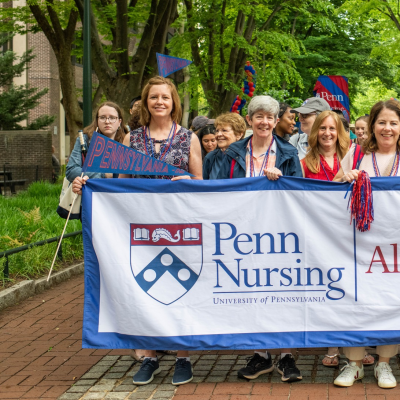The Path Forward
Penn Nursing is forging a new path to a Healthier, More Equitable Future. Here’s how they plan on getting there.
1. Innovation and Research

Innovation is solving pressing problems using rigorous methodological approaches that are infused with creativity and risktaking, and solutions for improving human health have a rich history in nursing. Nurses design novel approaches for sharing information and delivering care, and conduct critical research that helps students, patients, families, and communities learn, heal, and improve their lives. Now more than ever, we need nurse innovators and researchers who are continually finding new ways to address and solve the world’s health care challenges.
The Strategic Priorities
- A commitment to being at the vanguard of research in Precision, Data, and Implementation Science, with an explicit purpose of achieving health equity.
- The creation of an innovation ecosystem to develop solutions for challenging problems, cultivate and grow innovation partners, test innovations to improve health and health care outcomes, and prepare nurse innovators.
The Path Forward
The Penn Nursing Innovation Hub will be dedicated to integrating innovation across research, education, and clinical practice, and disseminating innovative methodologies and teaching to diverse audiences from faculty to students to community partners. What follows are examples of how each of its equally impactful areas may be funded.
1) TALENT: To expand its reach, functionality, and impact, innovation at Nursing requires investments for infrastructure, such as endowing/naming the Innovation Director position and support for key projects.
2) IMMERSION FOR STUDENTS: Immersing students in learning how to innovate in practice, via interactive course instruction, simulation, and clinical sessions, requires dedicated resources.
3) ELEVATE INNOVATION: We will continue to host events such as the annual Story Slam, the Innovation Accelerator Event, and others that evolve in support of innovation.
4) FACULTY DEVELOPMENT AND RESEARCH: Faculty are among our most valuable stakeholders, supporting the School’s innovation mission by preparing students. Fellowships, accelerators, and pilot grant programs will best support them.
5) SOCIAL JUSTICE COLLABORATORY: Led by faculty from Nursing and Engineering, this interdisciplinary project works with the community to idevelop interventions and solutions to critical social justice issues. Sample Giving Opportunity: a Social Justice Accelerator Fund to support the design and implementation of person-centered technologies.
2. Developing Experts and Leaders

Penn Nursing’s education program uses hands-on mentored instruction to transform what happens in the classroom into the realities of the clinical setting and beyond. The vision for the future is to invigorate an already competitive and high caliber program, evaluate programs at all levels, and implement changes in core competencies and essentials recommended by the AACN. And it all starts with developing experts and leaders in our undergraduate and graduate nursing programs in order to meet patient needs, improve health and health outcomes, and transform health care.
The Strategic Priorities
- Advance BSN and master’s entry programs that prepare nurses to meet changing public needs.
- Ensure our graduate portfolio prepares students to excel in nursing practice, now and in the future.
- Develop and execute an action plan that promotes innovation in nursing education, both in-residence and online.
- Foster diversity and inclusivity in our student population and throughout our curricula/ programs.
The Path Forward
The Penn Nursing Learning Lab will be a dynamic, nimble space in which all facets of nursing education are continually evaluated for ongoing enhancement/ modification. How can we change the way we think about what and how we teach to “democratize” education, increase accessibility, and impact health and health care everywhere?
What follows are ways that investing in the Penn Nursing Learning Lab will help Penn Nursing remain a leader in nursing education.
1) FACULTY LEARNING OPPORTUNITIES: Teaching residencies and innovation teaching grants will provide faculty, who serve as ‘academic entrepreneurs’, with resources and time to transform existing course content and to develop new content.
2) NEW SIMULATION TECHNOLOGIES: Including virtual reality and augmented reality tools in our courses help give our students the professional edge they need, directly supporting student learning and complementing clinical experiences.
3) STUDENT FINANCIAL AID/SCHOLARSHIPS: The average debt load of a nursing graduate student is over $90,000—this heavy burden (particularly on a typical nurse’s salary) can be substantially eased through financial aid/scholarships.
4) FACULTY CHAIRS (TERM AND ENDOWED): Dean appointed professorships are used to recruit, recognize, and retain star faculty, supporting their research and other scholarly activities.
5) ASPIRE: Aspire is a new suite of specialized academic products and services designed by Penn Nursing for individuals and institutions to advancing innovation in health care. Resources are needed for scholarships and to support program development and growth.
3. Transforming Policy and Practice

Clinical practice is central to nursing. Thanks to longstanding partnerships, we place students in clinical settings to gain confidence and practical, hands-on experience that leads to better outcomes for patients and providers. And, through practice, our faculty advance research and strengthen our ability to develop current, cutting-edge curricula that will transform the profession.
The Strategic Priorities
- Modify the Penn Nursing practice model to create financially viable models that support collaborative clinical education, practice, and translational research.
- Advance practicebased research, quality improvement, evidencebased and best practices, and scholarship within Penn Nursing and across all academic partners.
- Increase engagement with academic partners in the design of innovations to improve patient care, workflow processes, and environments.
- Strategically collaborate with Academic Practice Partners to promote a more diverse nursing workforce reflective of inclusivity, equality, and social justice
The Path Forward
The Consortium for Practice Excellence will serve as an umbrella initiative to capture activities and offer opportunities that will introduce students to evidence-based practice and strengthen their understanding and application of clinical practice in nursing. As nursing education and the profession continue to evolve, practice will remain the bedrock of knowledge and skills.
What follows are examples of giving opportunities linked to the Practice Excellence priority.
1) PARTNERSHIPS WITH NURSING SCHOOLS AND VETERAN’S ADMINISTRATIONS: This might include launching a Veterans’ Care Excellence program, collaboration on research to enhance care of veterans, or establishing a fellowship for student nurses who will do clinical rotations in VA hospitals, with the intention of pursuing a career there.
2) SCHOLARSHIPS FOR PRECEPTORS: Preceptors offer nursing students necessary supervision in clinical settings. Creating scholarships would incentivize greater participation among community organizations while strengthening and supporting their professional development and care in the community.
3) COMMUNITY PRACTICE SCHOLARS: Nursing students would be afforded the opportunity to work within underserved communities for their clinical rotations, thereby strengthening the communities while gaining valuable experience on how to effectively serve people from all backgrounds, cultures, and ethnicities.
4. Engaging Diverse Communities in Promoting Health

Social justice is a core value of Penn Nursing and community engagement is a fundamental aspect of Penn Nursing’s social justice mission. We are committed to incorporating social justice into our teaching practice and community engagement to improve health and promote positive social change in Philadelphia and around the world, and aim to serve as a model for other nursing educators and the nursing community at-large—adopting actions that are sustainable and measurable across education, policy, and practice.
The Strategic Priorities
- Implement a core set of principles and values that signal our commitment to a diverse, inclusive, and respectful environment, translating to our community work.
- Develop and enhance student and faculty competency and capacity to contribute to global health equity.
- Create innovative models for community and civic engagement that advance education, practice, and research while improving social equity and human welfare.
The Path Forward
The Nursing Social Justice Project will implement strategies across nursing education, research, and practice to address social and other inequities in health and health care, while serving our communities. Our ultimate goal is transform the landscape of diversity, equity, and inclusion for nursing, and by extension, the entire health care profession via targeted initiatives and ongoing community engagement.
What follows are sample giving opportunities that comprise the Nursing Social Justice Project.
1) SOCIAL JUSTICE EDUCATION: Anti-racism curriculum immersion/infusion, social justice fellowships, anti-bias training for students, faculty, and staff, and funding to critically examine and address structural barriers to health will transform how we prepare nurses, improving care delivery.
2) SCHOLARSHIPS: Financial aid for first-generation and underrepresented students is an evergreen priority.
3) RESEARCH: To improve the lives of under-represented individuals and communities and improve health and wellness for all people, we need to build the most diverse faculty and support research that addresses structural racism.
4) FACULTY SUPPORT: Endowed and term chairs as well as visiting professorships with a social justice bent are critical to the Nursing Social Justice project.
5. Strong Inclusive Infrastructure

While many faculty advance research, education, practice, and community priorities, other faculty and staff enable the systems by which initiatives progress and reach or exceed their stated goals. Galvanizing forces such as Operational Efficiencies, IT, Institutional Advancement, and Financial and Intellectual Resources all play a part in the synergy and acceleration of progress in meeting our plan’s strategic priorities. They are committed to service, innovation, collaboration, and high impact to facilitate the success of Penn Nursing.
The Strategic Priorities
- Upgrade current spaces to be state-of-the-art and maximize student experiences through redesigning classrooms to accommodate cutting-edge pedagogy and renovating student spaces to help facilitate better teaching and learning.
- Elevate the IT user experience to provide innovative and efficient technology services, resulting in improved digital intelligence and rapid data growth.
- Invest in people through enterprise-level development so that employees will feel competent, knowledgeable, and acclimated to their work environment and be enabled for success.
The Path Forward
The Fund for Enhanced Learning Spaces will allow us to remain competitive with our peer Nursing Schools across the country by continually upgrading our building (especially student learning and wellness spaces) to offer the most functional and attractive environment possible. Ideally, we will have the flexibility to address priority spatial needs as they arise in real-time to best serve our students. Each space upgrade offers the opportunity for a donor/s to have named recognition for their support in helping us to make this a reality.
1) STUDENT WELLNESS SPACE/LOUNGE: Mental health and wellness is important for all Penn students—especially those at Nursing. Due to their rigorous studies, as well as mandatory clinical rotations, nursing students often experience an added layer of stress. Our goal is to help them attain and maintain a healthy state of being by providing a rich reservoir of resources that educate and empower, as well as a comfortable space in which to do so.
2) UPDATED CLASSROOMS DESIGNED to accommodate new modalities of learning.
3) NEW FURNITURE to create a welcoming learning environment by enhancing functionality and improving aesthetics.
Back to Issue


